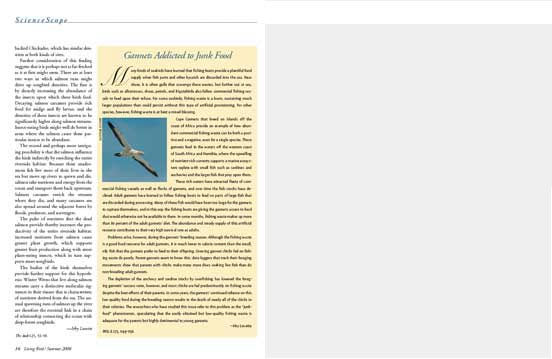Gannets Addicted to “Junk Food”
By Irby Lovette, director of the Fuller Evolutionary Biology Program
July 15, 2008
Many kinds of seabirds have learned that fishing boats provide a plentiful food supply when fish parts and other bycatch are discarded into the sea. Near shore, it is often gulls that scavenge these wastes, but farther out at sea, birds such as albatrosses, skuas, petrels, and frigatebirds also follow commercial fishing vessels to feed upon their refuse. For some seabirds, fishing waste is a boon, sustaining much larger populations than could persist without this type of artificial provisioning. For other species, however, fishing waste is at best a mixed blessing.
Cape Gannets that breed on islands off the coast of Africa provide an example of how abundant commercial fishing waste can be both a positive and a negative, even for a single species. These gannets feed in the waters off the western coast of South Africa and Namibia, where the upwelling of nutrient-rich currents supports a marine ecosystem replete with small fish such as sardines and anchovies and the larger fish that prey upon them.
These rich waters have attracted fleets of commercial fishing vessels as well as flocks of gannets, and over time the fish stocks have declined. Adult gannets have learned to follow fishing boats to feed on parts of large fish that are discarded during processing. Many of these fish would have been too large for the gannets to capture themselves, and in this way the fishing boats are giving the gannets access to food that would otherwise not be available to them. In some months, fishing waste makes up more than 80 percent of the adult gannets’ diet. The abundance and steady supply of this artificial resource contributes to their very high survival rate as adults.
Problems arise, however, during the gannets’ breeding season. Although the fishing waste is a good food resource for adult gannets, it is much lower in calorie content than the small, oily fish that the gannets prefer to feed to their offspring. Growing gannet chicks fed on fishing waste do poorly. Parent gannets seem to know this: data-loggers that track their foraging movements show that parents with chicks make many more dives seeking live fish than do non-breeding adult gannets.
The depletion of the anchovy and sardine stocks by overfishing has lowered the foraging gannets’ success rates, however, and most chicks are fed predominantly on fishing waste despite the best efforts of their parents. In some years, the gannets’ continued reliance on this low-quality food during the breeding season results in the death of nearly all of the chicks in their colonies. The researchers who have studied this issue refer to this problem as the “junk-food” phenomenon, speculating that the easily obtained but low-quality fishing waste is adequate for the parents but highly detrimental to young gannets.
Reference: Gremillet et al. A junk-food hypothesis for gannets feeding on fishery discards.Proceedings of the Royal Society of London B 275:1149-1156 (2008).

All About Birds
is a free resource
Available for everyone,
funded by donors like you
American Kestrel by Blair Dudeck / Macaulay Library



